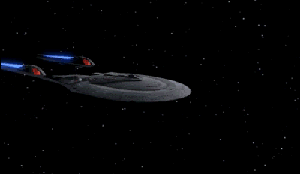| |
Can We
Travel Faster Than Light?
Physicist Thomas
Roman of Central Connecticut State University offers the
following response:
| Einstein's
special
theory of relativity predicts that nothing can exceed
the
speed of light. But special relativity applies when
spacetime is flat. When spacetime is curved, the theory
applies only "locally"--that is, over regions
of spacetime small enough to be considered flat. Consider
the analogy of a plane that is tangent to a sphere. The
flat geometry of the plane is a good approximation to
the geometry of the sphere when the size of the plane
is very small compared to the sphere's radius of curvature.
|
 |
| Animation: Kenneth
Jones FASTER-THAN-LIGHT TRAVEL, depicted in series
such as Star Trek, is not possible--except for maybe
inside a spacetime or Alcubierre warp bubble. |
|
In curved spacetimes, when we
compare two observers at large separation, we can no longer
use the "locally flat" approximation. In the plane-and-sphere
analogy, this situation would correspond to comparing two
observers on the sphere separated by a distance comparable
to the sphere's radius of curvature. Although each observer
could approximate the geometry in his or her local region
as a plane, there is no single plane that would be applicable
to both observers. Consequently, the two observers in curved
spacetime can each apply special relativity in their own local
region, but not globally.
A similar situation arises in
an expanding
universe. Here one should not think of the galaxies as
moving through space, but rather that the space between the
galaxies is expanding. Einstein's general theory of relativity,
on which such models are based, imposes no restrictions on
the rate
at which the expansion of space can drive the galaxies apart.
But special relativity still applies locally, in the sense
that a particle chasing a light ray can never catch up to
it. An analogy is to imagine bugs crawling on a rubber sheet.
By stretching the sheet we can make the bugs recede from each
other at arbitrarily high speeds, but no bug can crawl across
the sheet faster than a light beam.
In serious proposals for "warp drive," such as the
Alcubierre warp bubble, space is flat inside the bubble and
special relativity applies. In this region, nothing can travel
faster than light--relative to observers inside the bubble.
Outside the bubble, spacetime is also flat and no particle
can travel faster than light--relative to observers outside
the bubble. But because of the large expansion and contraction
of the spacetime in the wall of the bubble, the inside of
the bubble can move faster than light relative to the outside.
This would also be true of light rays inside the bubble; they
would be carried along by the spacetime warp, too. What causes
this mismatch of the two flat spacetime regions is the large
spacetime curvature in the bubble wall that separates the
regions
Next
->
|
|










